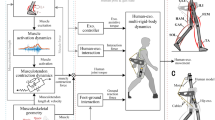Summary
The objective of this study was to determine the extent to which subjects modulate their elbow joint mechanical properties during ongoing arm movement. Small pseudo-random force disturbances were applied to the wrist with an airjet actuator while subjects executed large (1 rad) elbow joint movements. Using a lumped parameter model of the muscle, tendom and proprioceptive feedback dynamics, a time-varying system identification technique was developed to analyze the phasic changes in the elbow joint's mechanical response. The mechanical properties were found to be time-varying, and well approximated by a quasi-linear second-order model. The stiffness of the arm was found to drop during movement. The arm was always underdamped, with the damping ratio changing during movement. Inertia estimates were constant and consistent with previous measurements. Overall, the moving arm was found to be very compliant, with a peak stiffness value less than the lowest value measured during posture, and a natural frequency of less than 3 Hz. Changing the speed of movement, or the load from gravity, changed the stiffness measured, but not in strict proportion to the change in net muscle torque.
Similar content being viewed by others
References
Agarwal GC, Goodarzi SM, O'Neill WD, Gottlieb GL (1984) Time series modeling of neuromuscular system. Biol Cybern 51:103–111
Agarwal GC, Gottlieb GL (1977) Oscillation of the human ankle joint in response to applied sinusoidal torque on the foot. J Physiol 268:151–176
Aoki M, Yue PC (1970) On a priori error estimates of some identification methods. IEEE Trans on Automatic Control AC-15:541–548
Astrom KJ, Wittenmark B (1984) Computer controlled systems: theory and design. Prentice Hall, Englewood Cliffs, NJ
Atkeson CG, Hollerbach JM (1985) Kinematics features of unrestrained vertical arm movements. J Neurosci 5:2318–2330
Bennett DJ (1990) The control of human arm movement: models and mechanical constraints. PhD Thesis, MIT, Dept of Brain and Cognitive Sciences
Bennett DJ, Hollerbach JM (1988) The role of compliance in constrained ballistic arm trajectory formation. Soc Neurosci Conf Abstr 14:950
Bennett DJ, Xu Y, Hollerbach JM, Hunter IW (1990) Mechanical properties of the human arm during voluntary movement. Canadian Med and Biomed Eng Society Conference. June 9–12, Winnipeg, Manitoba, pp 89
Crossman ERFW, Goodeve PJ (1983) Feedback control of hand-movement and Fitts' law. Q J Expt Psych 35A:251–278
Feldman AG (1980) Superposition of motor programs 1. Rhythmic forearm movements in man. J Neurosci 5:81–90
Gottlieb GL, Agarwal GC (1978) Dependence of human ankle compliance on joint angle. J Biomech 11:177–181
Hoffer JA, Andreassen S (1981) Regulation of soleus muscle stiffness in premammillary cat: intrinsic and reflexive components. J Neurophysiol 45:267–285
Hogan N (1988) Planning and execution of multijoint movements. Can J Physiol Pharm 66:508–517
Hunter IW, Kearney RE (1982) Dynamics of human ankle stiffness: variation with mean ankle torque. J Biomech 15:747–752
Joyce GC, Rack PMH (1974) The forces generated at the human elbow joint in response to imposed sinusoidal movements of the forearm. J Physiol 240:351–374
Joyce GC, Rack PMH, Westbury DR (1969) The mechanical properties of cat soleus muscle during controlled lengthening and shortening movements. J Physiol 204:461–474
Kearney RE, Hunter IW (1982) Dynamics of human ankle stiffness: variation with displacement amplitude. J Biomech 15:753–756
Lacquaniti F, Licata F, Soechting JF (1982) The mechanical behavior of the human forearm in response to transient perturbations. Biol Cybern 44:35–46
Lanman JM (1980) Movement and the mechanical properties of the intact human elbow joint. PhD Thesis, MIT, Dept of Psychology
Liewellyn M, Yang JF, Prochazka A (1990) Human H-reflexes are smaller in difficult beam walking than in normal treadmill walking. Exp Brain Res 83:177–179
MacKay WA, Crammond DJ, Kwan HC, Murphy JT (1986) Measurements of human forearm viscoelasticity. J Biomech 19:231–238
MacNeil JB, Kearney RE, Hunter IW (1990) Identification of the time-varying stiffness of the human ankle. Canadian Med and Biomed Eng Soc Conference. June 9–12, Winnipeg, Manitoba, pp 177–179
Matthews PBS, Stein RB (1969) The sensitivity of the muscle spindle afferents to small sinusoidal changes in length. J Physiol 200:723–743
Prochazka A (1989) Sensorimotor gain control: a basic strategy of motor systems? Progr Neurobiol 33:281–307
Rack PMH, Westbury DR (1969) The effects of length and stimulus rate on the tension in the isolated cat soleus muscle. J Physiol 204:443–460
Rack PMH, Westbury DR (1974) The short range stiffness of active mammalian muscle and its effect on mechanical properties. J Physiol 240:331–350
Russell DL (1988) Arm motion in crank turning. MS Thesis, MIT, Dept Mech Eng
Sinkjaer T, Hayashi R (1989) Regulation of wrist stiffness by stretch reflex. J Biomech 22:1133–1140
Soechting JF, Dufresne JR, Lacquaniti F (1981) Time-varying properties of the myotatic response in man during some simple motor tasks. J Neurophysiol 46:1226–1243
Stein RB, Capaday C (1988) The modulation of human reflexes during functional motor tasks. TINS 11:328–332
Stein RB, Gordon T (1986) Nonlinear stiffness-force relationships in whole mammalian skeletal muscles. Can J Physiol Pharm 64:1236–1244
Xu Y (1991) Design and application of an airjet system for studying mechanical properties of human and robot arms. PhD Thesis, MIT, Aero and Astro Dept
Xu Y, Hunter IW, Hollerbach JM, Bennett DJ (1991) An airjet system for identification of the human arm joint mechanical properties. IEEE Trans Biomed Engrg (in press)
Author information
Authors and Affiliations
Rights and permissions
About this article
Cite this article
Bennett, D.J., Hollerbach, J.M., Xu, Y. et al. Time-varying stiffness of human elbow joint during cyclic voluntary movement. Exp Brain Res 88, 433–442 (1992). https://doi.org/10.1007/BF02259118
Received:
Accepted:
Issue Date:
DOI: https://doi.org/10.1007/BF02259118




